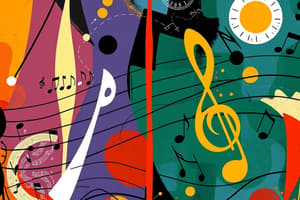Podcast
Questions and Answers
Mozart was recognized as an exceptional ______ at the age of six.
Mozart was recognized as an exceptional ______ at the age of six.
pianist
He created more than ______ compositions.
He created more than ______ compositions.
700
Beethoven was born in Bonn, ______, on December 17, 1770.
Beethoven was born in Bonn, ______, on December 17, 1770.
Germany
Beethoven began to lose his ______ at around the age of 30.
Beethoven began to lose his ______ at around the age of 30.
Symphony is derived from the word 'sinfonia' which means a harmonious sounding ______.
Symphony is derived from the word 'sinfonia' which means a harmonious sounding ______.
Mozart's well-known operas include 'The Marriage of Figaro' and 'Don ______'.
Mozart's well-known operas include 'The Marriage of Figaro' and 'Don ______'.
In Classical Opera, 'Opera Seria' usually implies ______ or tragic drama that employs mythological characters.
In Classical Opera, 'Opera Seria' usually implies ______ or tragic drama that employs mythological characters.
Beethoven's famous compositions include 9 ______.
Beethoven's famous compositions include 9 ______.
'Opera buffa' is known for its fun and ______ plot, typically with a happy ending.
'Opera buffa' is known for its fun and ______ plot, typically with a happy ending.
The 'Missa Solemnis' and the opera 'Fidelio' are among Beethoven's later ______.
The 'Missa Solemnis' and the opera 'Fidelio' are among Beethoven's later ______.
Beethoven is considered the composer who bridged the late Classical era and the early ______ era.
Beethoven is considered the composer who bridged the late Classical era and the early ______ era.
Alberti Bass is a type of ______ accompaniment that creates a smooth, flowing sound.
Alberti Bass is a type of ______ accompaniment that creates a smooth, flowing sound.
Largo is a style of music that is very ______ in tempo.
Largo is a style of music that is very ______ in tempo.
Franz Joseph Haydn was known as the 'Father of the ______' due to his contributions to the genre.
Franz Joseph Haydn was known as the 'Father of the ______' due to his contributions to the genre.
Wolfgang Amadeus Mozart is recognized as one of the greatest composers in the history of ______ music.
Wolfgang Amadeus Mozart is recognized as one of the greatest composers in the history of ______ music.
Mozart's famous works include 104 symphonies, 60 piano ______, and 25 operas.
Mozart's famous works include 104 symphonies, 60 piano ______, and 25 operas.
The Classical Era is also called the 'Age of ______'
The Classical Era is also called the 'Age of ______'
Harmony and texture in Classical music is generally ______.
Harmony and texture in Classical music is generally ______.
A ______ is a multi-movement work for solo instrument.
A ______ is a multi-movement work for solo instrument.
The three distinct sections of Sonata Allegro Form are Exposition, ______, and Recapitulation.
The three distinct sections of Sonata Allegro Form are Exposition, ______, and Recapitulation.
A ______ is a multi-movement work designed for an instrumental soloist and orchestra.
A ______ is a multi-movement work designed for an instrumental soloist and orchestra.
The ______ is a multi-movement work for orchestra, generally in four movements.
The ______ is a multi-movement work for orchestra, generally in four movements.
The term ______ refers to the volume of a sound or tone.
The term ______ refers to the volume of a sound or tone.
The principles of conformity in the Classical period were influenced by ancient Greek and Roman ______.
The principles of conformity in the Classical period were influenced by ancient Greek and Roman ______.
His famous compositions include 32 piano sonatas, 9 symphonies, and 5 concertos for ______.
His famous compositions include 32 piano sonatas, 9 symphonies, and 5 concertos for ______.
The known symphonies include Symphony No. 3 (Eroica), No. 5, and No. 6 (Pastoral), and No. 9 (Choral), which adds ______ to the orchestra.
The known symphonies include Symphony No. 3 (Eroica), No. 5, and No. 6 (Pastoral), and No. 9 (Choral), which adds ______ to the orchestra.
Instrumental music during the Classical period was primarily patronized by the ______.
Instrumental music during the Classical period was primarily patronized by the ______.
The musical instruments during the Classical period are divided into four main groups: string, ______, woodwind, and brass instrument.
The musical instruments during the Classical period are divided into four main groups: string, ______, woodwind, and brass instrument.
In the strings group, common examples include violin, viola, ______, and double bass.
In the strings group, common examples include violin, viola, ______, and double bass.
The woodwind family of instruments includes the flute, piccolo, oboe, clarinet, bassoon, and ______.
The woodwind family of instruments includes the flute, piccolo, oboe, clarinet, bassoon, and ______.
Percussion instruments produce sounds through hitting, shaking, or ______.
Percussion instruments produce sounds through hitting, shaking, or ______.
Tuned percussion instruments produce definite pitches while untuned instruments deliver indefinite sounds or ______.
Tuned percussion instruments produce definite pitches while untuned instruments deliver indefinite sounds or ______.
Flashcards are hidden until you start studying
Study Notes
Classical Period (1750-1820)
- The Classical Era, also called the "Age of Reason", spanned from 1750-1820.
- The aristocracy dominated cultural life during this time, acting as patrons of musicians and artists.
- The term "Classical" reflects a connection to ancient Greek and Roman art and literature, emphasizing formality, elegance, simplicity, and dignity.
Characteristics of Classical Music
- Harmony and texture predominantly leaned towards homophony.
- Dynamics, including loud and soft, were clearly expressed through the extensive use of crescendo and diminuendo.
- Alberti Bass, a style of broken chord accompaniment, was a common practice.
Elements of Music
- Melody: A combination of pitch and rhythm.
- Tempo: The speed at which music is played.
- Dynamics: The volume of a sound or tone.
- Texture: Homophonic texture consists of a melody supported by chords.
- Pitch: The rate of vibrations producing a sound, determining the degree of highness or lowness of a tone.
Instrumental Forms of the Classical Period
- Sonata: A multi-movement work for solo instrument. The term "sonata" originates from the Italian word "sonare", meaning "to make a sound".
- Sonata Allegro Form: The most significant form developed during the Classical era.
- Exposition: Introduces the theme.
- Development: Explores harmonic and textural possibilities of the thematic material.
- Recapitulation: Repeats the theme as presented in the exposition.
- Sonata Allegro Form: The most significant form developed during the Classical era.
- Concerto: A multi-movement work designed for an instrumental soloist and orchestra, typically with three movements: fast, slow, and fast.
- Symphony: A multi-movement work for orchestra, generally comprising four movements: fast, slow, medium, and fast. "Symphony" derives from the Italian word "sinfonia," meaning "a harmonious sounding together".
Vocal Music of the Classical Period
- Opera: A drama set to music performed in a theatrical setting by singers and musicians.
- Opera Seria (Serious Opera): Employs mythological characters and focuses on heroic or tragic drama.
- Opera Buffa (Comic Opera): Italian opera known for its humorous plot and typically features a happy ending.
Musical Styles of Classical Music
- Alberti Bass: A specific broken chord accompaniment pattern: lowest note - highest note - middle note - highest note, creating a flowing, sustained sound.
- Allegro: A fast, brisk, and lively musical tempo.
- Largo: A very slow tempo in Classical music.
- Suite: A collection of short musical pieces assembled to create a larger work.
Franz Joseph Haydn (1732-1809)
- Born in Rohrau, Austria, and died in Vienna.
- His life was described as a rags-to-riches story, as he rose in social status through his music.
- His personality and character were reflected in his music: calm, balanced, serious with humorous touches.
- Known as the "Father of the Symphony" and "Father of the String Quartet" for his important contributions to these genres.
- Many of his symphonies have nicknames, such as the "Surprise Symphony," "The Clock," and "The Military."
- He also composed chamber piano music and choral works.
Wolfgang Amadeus Mozart (1756-1791)
- One of the most prominent composers of the Classical Period.
- His life was also a rags-to-riches story.
- He was known as the "Father of the Symphony."
- Among his famous works are over 100 symphonies, 60 piano sonatas, 68 string quartets, masses, oratorios, and 25 operas (10 lost).
- Many of his symphonies have nicknames such as the "Surprise Symphony," "The Clock," and "The Military."
- He also composed chamber piano music and choral works.
- Born in Salzburg, Austria, and died in Vienna.
- Widely recognized as one of the greatest composers in Western musical history and considered a musical genius.
- A child prodigy, displaying exceptional musical talent at a young age.
- He began composing at age seven and wrote a vast repertoire of sonatas, concertos, symphonies, religious works, and operas by age thirteen.
- He created over 700 compositions.
- He experienced poverty due to financial mismanagement and died young, buried in an unmarked grave.
- Some of Mozart's most famous works are: "The Marriage of Figaro" (1786), “Don Giovanni (1789), and "The Magic Flute", which achieved great popularity.
- Other known works: "Eine Kleine Nachtmusik," Symphony No. 40 in G Major, and Sonata No. 11 in A Major K311.
- Mozart experimented with various musical styles and composed a prolific amount of music.
Ludwig Van Beethoven (1770-1827)
- Born and baptized in Bonn, Germany, and died in Vienna, Austria.
- Came from a family of musicians and began studying music at a young age.
- Bridged the late Classical era and the early Romantic era.
- He was a brilliant pianist and composer.
- Began to go deaf around the age of 30 (1796).
- Continued composing with the help of an assistant and hearing aids, even after losing his hearing.
- Some of his most famous compositions were created during his period of deafness.
- His notable works include: 32 piano sonatas, 21 sets of variations, 9 symphonies, 5 piano concertos, 16 string quartets, and choral music.
- His works include the Piano Concerto No. 5 "Emperor", "Missa Solemnis" (1818-1823) and opera "Fidelio" (1805).
- Famous symphonies:
- Symphony No. 3 (Eroica)
- Symphony No. 5
- Symphony No. 6 (Pastoral)
- Symphony No. 9 (Choral), which features vocal parts.
Related Art Forms
- In the mid-18th century, Europe embraced a new style known as Classicism, influencing architecture, literature, and the arts.
- This shift was partially driven by changes in economic and social structures.
- Instrumental music was primarily funded by the nobility.
Related Historical Events
- The French Revolution and the American Declaration of Independence in 1776.
- The American Revolution.
- The Napoleonic Wars.
Musical Instruments of the Classical Period
- The instruments during the Classical Period can be broadly categorized into four groups:
- Strings
- Percussion
- Woodwinds
- Brass instruments
The Strings
- Common examples include the violin, viola, cello, and double bass.
- Techniques include plucking with fingers or a plectrum, striking strings with a mallet, and bowing the strings.
String Section
- Violin
- Viola
- Cello
- Double Bass
The Woodwinds
- This family of instruments consists of tubes with an opening at one end and a mouthpiece at the other.
- Keys are rows of holes covered by metal caps.
- Sound changes depending on air flow exiting the instrument.
- Instruments in descending general tone order: flute, piccolo, oboe, clarinet, bassoon, and saxophone.
The Percussion
- Percussion instruments produce sound through hitting, shaking, or scraping techniques.
- They can be tuned or untuned, affecting the pitch they generate.
- Tuned instruments produce specific pitches while untuned instruments create undefined sounds.
Studying That Suits You
Use AI to generate personalized quizzes and flashcards to suit your learning preferences.





